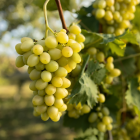
The Rise of Volcanic Wine
In recent years, ‘Volcanic’ wines have been much discussed in the wine world, now increasingly featured on the wine lists of top restaurants and in specialist retailers. While the category spans numerous regions, styles, and even soil types, these wines are considered unique due to the unusual soils in which the vines grow.
By ‘Volcanic’ Soils, we typically mean those formed from ancient or recent eruptions, where the soil is comprised mainly of ‘Tuff’ rock, a product of volcanic origin, and where the finest debris from historic volcanic eruptions slowly settles and hardens into layers of rock over time.
The recent interest in volcanic wines is undeniably linked to a global shift in the most popular wine styles. The preferences of many drinkers and sommeliers have shifted toward wines that emphasise precision rather than richness, a style commonly embodied by Volcanic wines. For a myriad of reasons, the profiles of these tend to be shaped by leaner fruit expression, firmer acidity, and perhaps a slightly mineral edge, which has proved highly fashionable in recent years.
It would be remiss not to recognise the narrative element in the rise of these volcanic wines. Conveying a sense of place when talking about Volcanic wines is remarkably straightforward, and it’s easy to see why so many consumers connect so clearly with the story and visual identity of these regions, imagining vines growing in challenging yet mineral-rich soils shaped by the Earth’s most dramatic and explosive forces. It is perhaps no surprise, then, that two of the most in-vogue volcanic wine regions, Etna and Santorini.
Many volcanic regions have also seen investment and renewed interest in their grape growing and winemaking facilities. An overall trend of premiumisation in the wine market has led to areas once considered too remote or challenging to farm cost-effectively being reevaluated for their potential to produce characterful wines, as demand has slowly shifted toward more interesting, premium wines.
This has generally resulted in significant improvements in quality for many volcanic wine regions, alongside much greater availability in key global markets. Perhaps the best example of this is Etna wine, which has seen a momentous focus on quality in recent years to such an extent that the region is now in the process of applying for DOCG status to recognise this quality and unique style.
What is the ‘Volcanic‘ character?
One of the most consistent traits across the range of volcanic wines is their elevated acidity. Several factors contribute to this, and while most are not exclusive to volcanic soils, the combination produces wines of unique character.
High Elevation
Many volcanic regions occur at high elevations, unsurprisingly, given that they are fundamentally the result of volcanic eruptions forcing geological material through the Earth’s crust. This higher altitude generally leads to cooler nights, which slows respiration in the grapes and helps preserve this acidity.
Well-drained Soils
Volcanic soils, especially those which are most clearly composed of ash, pumice, and basalt, tend to have excellent drainage. In otherwise highly fertile volcanic soils, which might encourage excessive green growth of the vine, this moderates vine vigour. This also plays a role in the linear, firm palate structure, which tasters of many volcanic wines often describe.
This isn’t due to minerals passing directly into the wine (a common misconception) but rather to how the vine responds to the soil environment. Low vigour from excellent drainage often leads to grapes with thicker skins, contributing phenolic grip in whites and fine, powdery tannins in reds.
Aromatic Profile
Some volcanic wines are described as exhibiting smoky or flinty notes. Whilst one likes to imagine these flavours being drawn from the volcanic rock itself, a hint at the fiery history of these sites, the truth is sadly less romantic. Whilst winemakers working in Volcanic soils might credit the soils for these flavour profiles, the same is true of producers working in limestone-heavy soils (a wholly un-volcanic soil).
The science suggests, therefore, that such a character is more likely a result of winemaking decisions such as a reductive environment during fermentation and maturation, and the overall leaner fruit profile often associated with these sites, which allows this character to shine through more prominently.
Volcanic Soils & Phylloxera
One unique characteristic of Volcanic soils is that phylloxera, the vine-destroying insect which devastated European vineyards in the 19th century, struggles to survive in some types of volcanic soils, for a handful of reasons.

There are a few reasons for phylloxera’s difficulty in these environments:
- Excessively Porous Soils & High Silica Content
Sandy or ash-based volcanic soils can be too loose for phylloxera to establish stable colonies, as the insect requires fine soil structure to move between roots. Some volcanic soils contain large amounts of silica or pumice particles, which hold little water and can create similarly inhospitable conditions for the insect responsible. - Isolation & Geography
Volcanic islands or mountain regions often remained isolated at the height of the phylloxera crisis, preventing the spread of the insect in the first place. This has meant that certain volcanic regions, such as parts of Santorini, the Canary Islands, and some isolated mainland European sites, still grow vines on original rootstocks. These ungrafted vines often reach considerable ages, largely unmatched elsewhere in the world, contributing to concentrated fruit and deep-rooted expressions of place.
Volcanic wines have captured significant attention for a range of reasons, both related to the wines themselves and to the stories we tell about them. Their acidity and clarity align with modern tastes, while their origins offer a distinct narrative grounded in a clear sense of place.
The science behind their unique character (Porous soils, often higher elevation, and slow, steady ripening) explains why they often stand apart from wines grown on more traditional calcareous soils. Add the historical element of phylloxera-resistant vineyards, and it becomes clear why volcanic wines continue to rise in prominence.
Far from a trend, they represent a unique category that is likely to remain compelling for years to come.
Related Articles

Bill Koch’s Grand Wine Auction: Region Performance Report
By Jonathan Stevenson

Bill Koch’s Grand Wine Auction: A Collector’s Legacy
By Jonathan Stevenson




